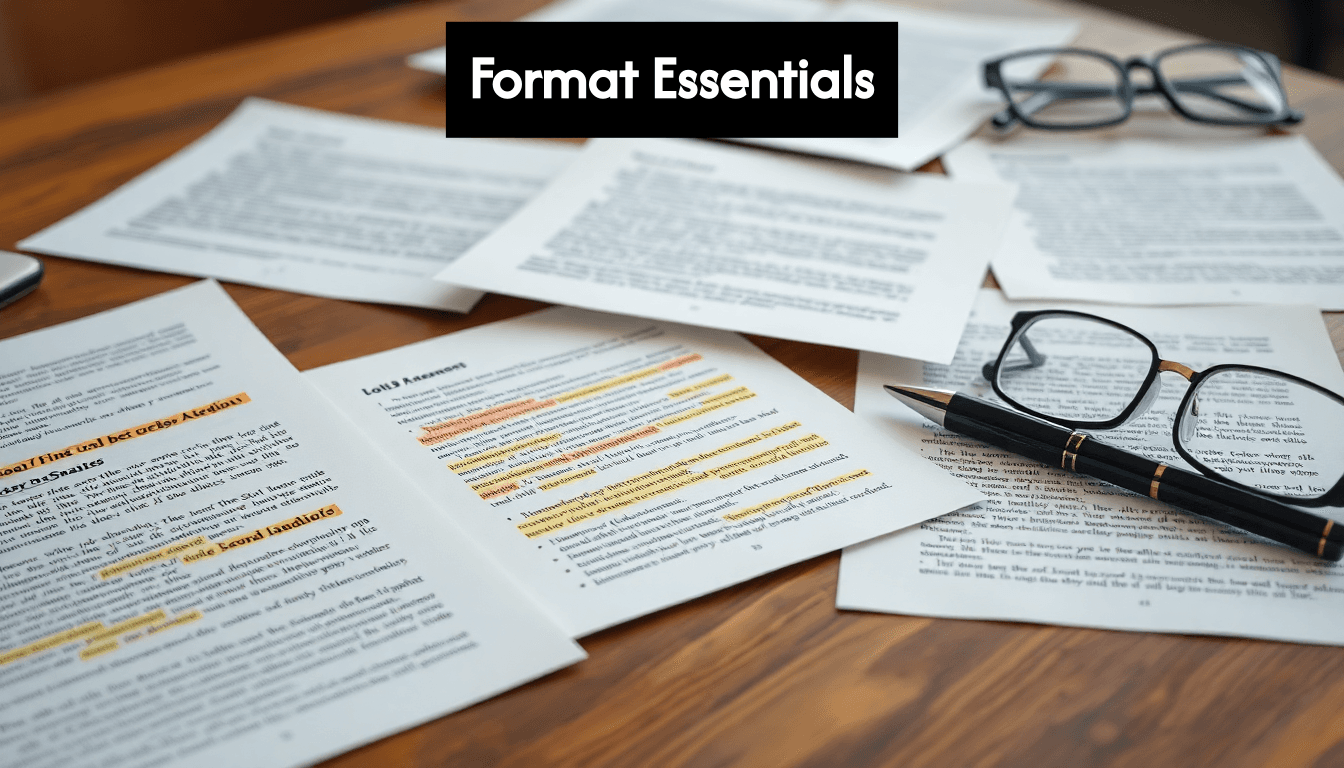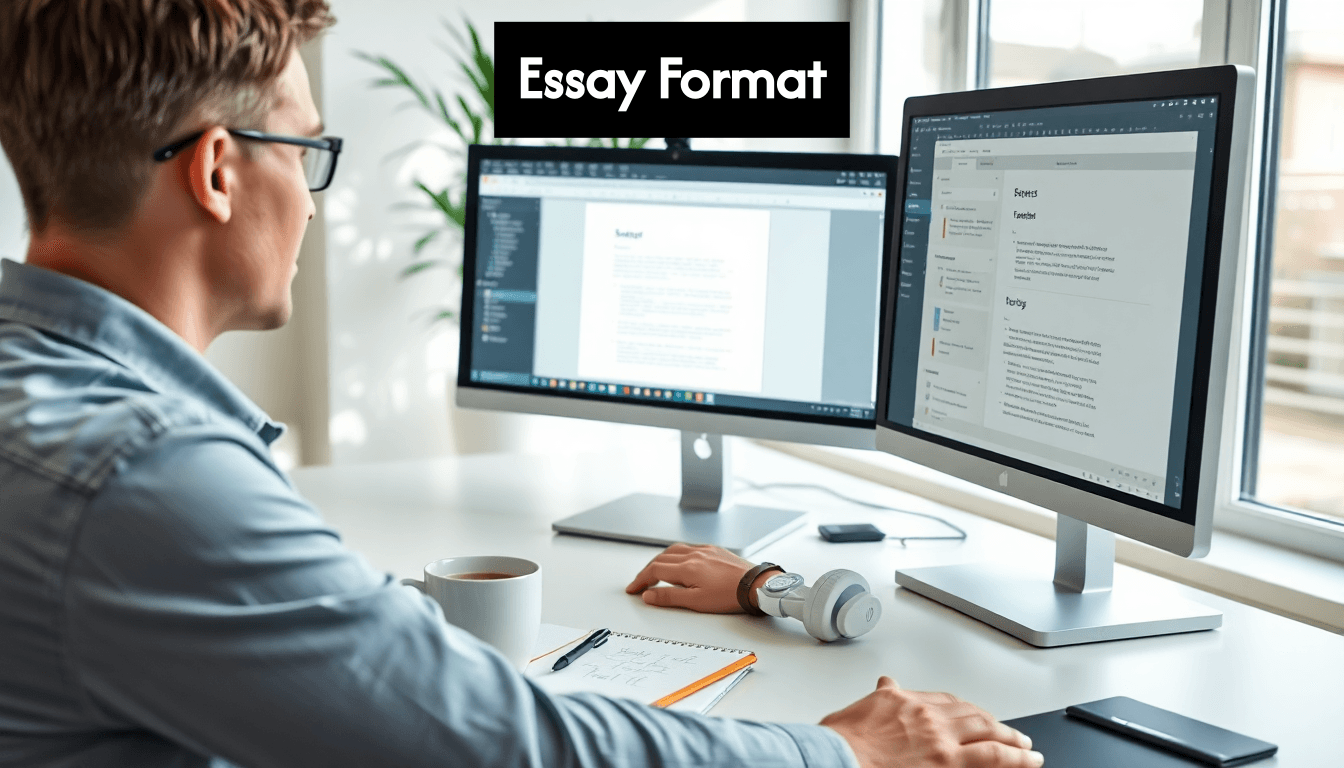Blog
Learning Materials
Guide ultime 2025 : Les différents formats dessais expliqués
Updated: April 25, 2025

Les formats dessai façonnent la manière dont vos idées sont comprises et appréciées. La plupart des gens pensent que seul le contenu compte, mais voici une surprise : maîtriser différents formats peut améliorer la clarté de votre écriture jusquà 50 %. Pourtant, le véritable rebondissement est que le format nest pas seulement une question de règles—cest loutil secret qui aide votre message à se connecter, persuader et rester dans lesprit de vos lecteurs. Comprendre cela change tout dans votre approche du prochain essai.
Table des Matières
- Comprendre les Essentiels du Format dEssai
- Le But du Formatage des Essais
- Éléments Communs à Travers les Formats dEssai
- Pourquoi le Formatage est Important
- Variations Populaires de Formats dEssai
- Formats dEssai Académiques
- Formats Narratifs et Descriptifs
- Formats Comparatifs et Réflexifs
- Sélectionner le Bon Format dEssai
- Considérer les Exigences de Votre Devoir
- Aligner le Format avec le But
- Considérer Votre Public
- Adapter le Format au Contenu
- Équilibrer Créativité et Convention
- Conseils dExperts pour le Formatage des Essais
- Parfaire Votre Formatage Technique
- Rédiger des Paragraphes Stratégiques
- Optimiser Votre Introduction et Conclusion
- Utiliser les Titres et Sous-titres Stratégiquement
- Formatage Méticuleux des Citations
Résumé Rapide
| Point Clé | Explication |
|---|---|
| Comprendre les Essentiels du Format | Maîtriser divers formats dessai améliore la lisibilité et organise les idées de manière logique, fournissant une base solide pour une communication efficace. |
| Sélectionner le Format en Fonction du But | Alignez le format dessai choisi avec vos objectifs décriture—quil sagisse dinformer, de persuader ou de partager des expériences personnelles—pour maximiser limpact. |
| Respecter les Exigences du Devoir | Passez toujours en revue les directives du devoir pour les attentes spécifiques en matière de formatage et de style de citation afin dassurer la conformité. |
| Optimiser Votre Introduction et Conclusion | Rédigez des introductions engageantes et des conclusions perspicaces pour captiver les lecteurs et laisser une impression durable sur vos principaux arguments. |
| Utiliser les Titres pour lOrganisation | Implémentez des titres et sous-titres pour améliorer la navigation dans les essais plus longs, signalant clairement les différentes sections aux lecteurs. |
Comprendre les Essentiels du Format dEssai

Chaque écrit suit certains schémas et structures, et les essais ne font pas exception. Comprendre les différents types de formats dessai est fondamental pour tout écrivain cherchant à communiquer efficacement ses idées. Que vous soyez un étudiant travaillant sur un devoir académique ou un professionnel rédigeant un texte persuasif, maîtriser les formats dessai fournit la base pour une écriture claire et organisée.
Le But du Formatage des Essais
Le formatage des essais ne consiste pas seulement à suivre des règles arbitraires—il remplit plusieurs fonctions critiques dans le processus décriture. Un essai bien structuré améliore la lisibilité et aide à organiser des idées complexes dans une séquence logique. Des recherches de SharkPapers indiquent quun format dessai approprié améliore non seulement la lisibilité mais démontre également une compréhension académique et un professionnalisme.
Le formatage fournit un cadre qui guide à la fois lécrivain et le lecteur à travers largument ou le récit. Pour les écrivains, il offre une feuille de route pour organiser les pensées de manière cohérente. Pour les lecteurs, il crée des repères qui rendent le contenu plus facile à naviguer et à digérer.
Éléments Communs à Travers les Formats dEssai
Quel que soit le type spécifique de format dessai que vous utilisez, certains éléments restent constants à travers la plupart des styles décriture :
-
Introduction : Cette section douverture présente votre sujet, fournit les informations de base nécessaires et établit votre thèse ou argument principal. Une introduction solide capte lintérêt tout en fixant des attentes claires sur ce qui suit.
-
Paragraphes du Corps : Le cœur de votre essai où vous développez vos principaux points avec des preuves, des exemples et des analyses. Chaque paragraphe se concentre généralement sur une seule idée qui soutient votre thèse globale.
-
Conclusion : La section finale qui synthétise vos arguments et laisse aux lecteurs une compréhension claire de votre message ou perspective. Elle reformule souvent la thèse et résume les points clés sans simplement les répéter.
La structure en cinq paragraphes représente lun des formats dessai les plus fondamentaux, en particulier pour les débutants. Cette structure comprend une introduction avec une déclaration de thèse, trois paragraphes du corps soutenant des points spécifiques, et une conclusion résumant les principaux arguments.
Pourquoi le Formatage est Important
La manière dont vous structurez votre essai a un impact significatif sur la réception de vos idées. Pensez au formatage comme à larchitecture de votre écriture—tout comme un bâtiment a besoin dun support structurel approprié pour se tenir debout, votre essai a besoin dun formatage approprié pour communiquer efficacement votre message.
Lorsque vous maîtrisez différents types de formats dessai, vous gagnez la flexibilité dadapter votre écriture à divers contextes et objectifs. Les essais académiques nécessitent souvent des structures formelles avec des déclarations de thèse claires et des preuves à lappui. Les essais personnels peuvent permettre plus de créativité dans lorganisation tout en maintenant la cohérence.
Comprendre ces essentiels fournit la base pour explorer les différents types de formats dessai plus en détail. Chaque format sert un but spécifique et suit des conventions particulières que nous examinerons tout au long de cet article. En reconnaissant quand et comment appliquer différents formats, vous renforcerez considérablement vos capacités décriture et vous assurerez que vos idées atteignent les lecteurs avec un impact maximal.
Variations Populaires de Formats dEssai
Les formats dessai varient largement selon les institutions éducatives, les disciplines et les objectifs. Reconnaître ces différents types de formats dessai permet aux écrivains dadapter leur approche pour répondre à des exigences spécifiques et communiquer efficacement leurs idées. Explorons certains des formats dessai les plus courants que vous rencontrerez dans les milieux académiques et professionnels.
Formats dEssai Académiques
Dans lécriture académique, plusieurs formats standard dominent le paysage, chacun avec des caractéristiques et des applications distinctes.
Le format dessai expositif se concentre sur lexplication dun sujet de manière claire et concise. Ce format repose sur une structure simple avec une déclaration de thèse claire suivie de paragraphes de soutien qui présentent des preuves, des analyses et des explications. Les essais expositifs privilégient les faits aux opinions et maintiennent un ton objectif tout au long. Ils sont souvent assignés dans les milieux éducatifs pour démontrer la compréhension dun sujet ou dun concept.
Le format dessai argumentatif sappuie sur une structure similaire mais diffère par son objectif et son contenu. Ce format exige que les écrivains prennent position sur un sujet débattable et soutiennent leur position avec des preuves convaincantes. Un essai argumentatif bien conçu reconnaît les points de vue opposés avant de les réfuter avec des contre-arguments plus solides. Lobjectif est de persuader les lecteurs de la validité dune perspective spécifique grâce à un raisonnement logique et des preuves.
Le format dessai analytique examine un sujet en le décomposant en ses composants. Plutôt que de simplement décrire les éléments, les essais analytiques évaluent comment ces composants fonctionnent ensemble et ce quils révèlent sur lensemble. Ce format est particulièrement courant en littérature, études cinématographiques et sciences sociales où la pensée critique et linterprétation sont valorisées. La structure progresse généralement des observations générales aux idées spécifiques.
Formats Narratifs et Descriptifs
Tous les formats dessai ne se concentrent pas sur largumentation académique. Certains privilégient la narration ou les détails sensoriels pour engager les lecteurs à un niveau plus personnel.
Le format dessai narratif suit les conventions de la narration, avec des personnages, des dialogues, un cadre et une intrigue. Contrairement aux œuvres purement fictives, les essais narratifs racontent généralement des expériences personnelles et incluent des éléments réflexifs qui révèlent une signification ou une importance. Ces essais emploient souvent la perspective à la première personne et une organisation chronologique tout en maintenant la structure de base introduction-corps-conclusion.
Le format dessai descriptif crée une image vivante dune personne, dun lieu, dun objet ou dune expérience à travers des détails sensoriels soigneusement choisis. Ce format repose fortement sur le langage figuratif, les métaphores et un vocabulaire précis pour aider les lecteurs à visualiser et à se connecter avec le sujet. Bien que moins structuré que certains formats académiques, les essais descriptifs efficaces maintiennent toujours une organisation cohérente, souvent arrangée spatialement ou par ordre dimportance.
Formats Comparatifs et Réflexifs
Certains formats dessai servent spécifiquement à examiner les relations entre les sujets ou à explorer la croissance personnelle.
Le format dessai de comparaison et de contraste examine les similitudes et les différences entre deux ou plusieurs sujets. Ce format peut être organisé de deux manières principales : sujet par sujet (discutant de tous les aspects dun sujet avant de passer au suivant) ou point par point (abordant le même aspect à travers tous les sujets avant de passer au point suivant). Lintroduction établit la relation entre les sujets, tandis que la conclusion synthétise les idées tirées de la comparaison.
Le format dessai réflexif combine des éléments narratifs avec une analyse critique dexpériences personnelles ou dobservations. Contrairement aux essais purement narratifs, les formats réflexifs exigent que les écrivains interprètent les expériences, considèrent des perspectives alternatives et articulent les leçons apprises ou la croissance réalisée. Ce format permet une structure plus flexible tout en maintenant la cohérence à travers une organisation thématique.
Comprendre ces différents types de formats dessai fournit aux écrivains des outils précieux pour aborder diverses tâches décriture. Le format que vous choisissez doit saligner avec votre objectif, votre public et votre contenu. Chaque variation offre des avantages uniques pour organiser et présenter des idées efficacement, vous permettant de sélectionner lapproche qui sert le mieux vos objectifs et exigences décriture spécifiques.
Sélectionner le Bon Format dEssai
Choisir le format dessai approprié ne consiste pas seulement à suivre des règles arbitraires—il sagit de maximiser lefficacité de votre communication. Le bon format sert de véhicule à vos idées, les aidant à atteindre votre public avec clarté et impact. Explorons comment déterminer lequel des nombreux types de formats dessai servira le mieux vos objectifs décriture spécifiques.
Considérer les Exigences de Votre Devoir
Le premier et le plus important facteur dans la sélection dun format dessai est de comprendre les exigences de votre devoir. Les institutions académiques spécifient souvent des directives de formatage particulières qui doivent être suivies précisément. Ces exigences tombent généralement dans deux catégories : les formats structurels (comment le contenu est organisé) et les styles de citation (comment les sources sont documentées).
Pour lécriture académique, les styles de citation courants incluent APA, MLA et Chicago. Selon EssayShark, le format APA exige une police Times New Roman de 12 points, un double interligne, des marges de 1 pouce, une page de titre, un résumé de 150-250 mots, des citations dans le texte avec le nom de famille de lauteur et lannée, et une page de références. Les formats MLA et Chicago ont leurs propres exigences distinctes qui servent différentes disciplines académiques.
Examinez attentivement votre consigne de devoir pour des instructions spécifiques concernant :
- Le type dessai requis (argumentatif, analytique, etc.)
- Le style de citation (APA, MLA, Chicago, etc.)
- Les attentes structurelles (nombre de paragraphes, inclusion de sections spécifiques)
- Les exigences de longueur (nombre de mots ou de pages)
Aligner le Format avec le But
Au-delà du respect des exigences de base, considérez ce que vous essayez daccomplir avec votre écriture. Différents types de formats dessai servent différents objectifs :
Si vous essayez de persuader votre public, un format argumentatif avec une déclaration de thèse claire, des preuves à lappui et lanticipation des contre-arguments sera le plus efficace. Cette structure aide à construire un cas convaincant pour votre position.
Lorsque vous expliquez un sujet complexe, un format expositif avec une progression logique des idées aidera les lecteurs à saisir des concepts difficiles. Cette approche met laccent sur la clarté et la compréhension à travers des informations bien organisées.
Si vous partagez une expérience personnelle avec des idées significatives, un format narratif ou réflexif vous permet dengager les lecteurs émotionnellement tout en transmettant des messages importants. Ces formats offrent de lespace pour la narration et lanalyse.
Considérer Votre Public
Les attentes et les connaissances de base de vos lecteurs prévus devraient influencer de manière significative votre sélection de format. Demandez-vous :
Quel niveau de formalité est approprié ? Les publics académiques sattendent généralement à des formats plus structurés avec un langage formel et des citations complètes. Les publics généraux pourraient mieux répondre à des structures plus accessibles avec des éléments engageants.
Quelle est la familiarité de votre public avec le sujet ? Les publics ayant des connaissances de base limitées pourraient bénéficier de formats qui intègrent plus déléments explicatifs, tandis que les publics spécialisés pourraient apprécier des approches analytiques plus sophistiquées.
Quelles sont les attentes de votre public ? Différentes disciplines et contextes établissent des conventions spécifiques que les lecteurs sattendent à ce que les écrivains suivent. Répondre à ces attentes aide à établir votre crédibilité.
Adapter le Format au Contenu
La nature de votre contenu devrait informer votre choix de format. Les sujets complexes avec de multiples facettes pourraient bénéficier dun format de comparaison et de contraste qui examine systématiquement différentes dimensions. Les sujets nécessitant une analyse approfondie pourraient fonctionner mieux avec des formats analytiques qui décomposent les composants pour examen.
Considérez combien de preuves vous devrez présenter. Les essais riches en recherches nécessitent généralement des formats qui accommodent une présentation substantielle de citations et de preuves, tandis que les sujets plus conceptuels pourraient bénéficier de formats qui permettent un raisonnement et une explication étendus.
Le format dessai en cinq paragraphes fonctionne bien pour les sujets simples qui peuvent être développés à travers trois points principaux. Les sujets plus complexes pourraient nécessiter des formats étendus avec des sections et sous-sections supplémentaires pour aborder adéquatement divers aspects.
Équilibrer Créativité et Convention

Bien que suivre les conventions établies soit important, les essais les plus efficaces adaptent souvent les formats de manière réfléchie pour servir leurs objectifs spécifiques. Considérez où ladhésion aux conventions est nécessaire et où ladaptation créative pourrait améliorer votre communication.
Même dans les formats structurés, vous pouvez incorporer une voix personnelle, des structures de phrases variées et des exemples engageants pour rendre votre écriture distinctive. La clé est de comprendre le but derrière les conventions de formatage afin de pouvoir prendre des décisions éclairées sur quand les suivre strictement et quand les adapter délibérément.
En considérant soigneusement ces facteurs, vous pouvez sélectionner un format dessai qui non seulement répond aux exigences formelles mais améliore également votre capacité à communiquer efficacement avec votre public prévu. Le bon format fonctionne invisiblement en arrière-plan, permettant à vos idées de prendre le devant de la scène et de faire le maximum dimpact sur vos lecteurs.
Conseils dExperts pour le Formatage des Essais
Maîtriser les différents types de formats dessai nécessite plus que de comprendre leurs structures de base. Les écrivains à succès mettent en œuvre des approches stratégiques pour améliorer la lisibilité, renforcer les arguments et respecter les normes académiques. Ces conseils dexperts vous aideront à élever votre formatage dessai, quel que soit le style spécifique que vous utilisez.
Parfaire Votre Formatage Technique
Un formatage technique cohérent crée une impression professionnelle et garantit que vos idées prennent le devant de la scène sans distractions. Selon PaperGen.AI, le formatage typique des essais académiques comprend des marges de 1 pouce, un double interligne, une police de 12 points (en utilisant Times New Roman, Arial ou Calibri), et une indentation de paragraphe de 0,5 pouce.
Au-delà de ces bases, faites attention au format de votre page de titre, qui varie souvent selon le style de citation. Le format APA exige généralement le titre de lessai (centré et en gras), votre nom, laffiliation institutionnelle, les informations sur le cours et la date de soumission. Le format MLA intègre souvent ces informations dans la première page plutôt que dutiliser une page de titre séparée.
La cohérence est extrêmement importante dans le formatage technique. Utilisez la même police tout au long, maintenez un espacement uniforme entre les sections et appliquez les styles de titre de manière cohérente. Même de petites incohérences peuvent créer une impression disjointe qui sape votre crédibilité.
Rédiger des Paragraphes Stratégiques
Les paragraphes servent de blocs de construction à votre essai, et leur structure a un impact significatif sur lefficacité de vos idées. Plutôt que de considérer les paragraphes comme des divisions arbitraires, abordez-les comme des unités complètes de pensée.
Commencez chaque paragraphe par une phrase daccroche forte qui énonce clairement lidée principale. Cela aide les lecteurs à comprendre le but du paragraphe et comment il se connecte à votre argument global. Suivez avec des preuves à lappui, des exemples ou un raisonnement qui développe la phrase daccroche. Terminez par une phrase de conclusion qui résume le point du paragraphe ou fait la transition vers lidée suivante.
La longueur des paragraphes compte aussi. Des paragraphes trop longs (dépassant 200 mots) peuvent submerger les lecteurs et obscurcir vos points clés. Des paragraphes extrêmement courts peuvent sembler sous-développés. Visez des paragraphes entre 100-150 mots pour lécriture académique, avec une certaine variation pour lemphase ou les transitions.
Optimiser Votre Introduction et Conclusion
Ces deux sections reçoivent une attention disproportionnée de la part des lecteurs et des évaluateurs, rendant leur formatage particulièrement important.
Pour les introductions, commencez par un accrocheur qui attire les lecteurs sans recourir à des clichés ou des déclarations trop larges. Fournissez suffisamment de contexte pour orienter les lecteurs vers votre sujet avant de présenter votre déclaration de thèse. Formatez votre déclaration de thèse de manière distincte—elle doit être claire, spécifique et positionnée de manière proéminente (généralement à la fin de votre introduction).
Pour les conclusions, évitez de simplement reformuler votre introduction. Au lieu de cela, synthétisez vos principaux points et articulez leur signification. De nombreuses conclusions efficaces suivent une structure zoom out—commençant par une reformulation de la thèse, résumant les arguments clés, et se terminant par des implications plus larges ou un appel à laction. Cela crée un sentiment de clôture tout en soulignant limportance de votre argument.
Utiliser les Titres et Sous-titres Stratégiquement
Pour les essais plus longs, les titres et sous-titres fournissent des repères organisationnels précieux qui aident les lecteurs à naviguer dans votre argument. Ils divisent le texte dense, mettent en évidence les sections clés et créent une hiérarchie visuelle.
Formatez vos titres de manière cohérente selon leur niveau dimportance. Dans le style APA, par exemple, les titres de niveau 1 sont centrés et en gras, tandis que les titres de niveau 2 sont alignés à gauche et en gras. Assurez-vous que vos titres sont descriptifs plutôt que génériques—ils doivent résumer le contenu qui suit.
Même lorsque les titres ne sont pas explicitement requis, envisagez de les utiliser pour des arguments complexes ou des essais dépassant 1 500 mots. Ils démontrent votre conscience organisationnelle et rendent votre travail plus accessible aux lecteurs.
Formatage Méticuleux des Citations
Un formatage précis des citations signale lintégrité académique et lattention aux détails. Plutôt que de considérer les citations comme de simples détails techniques, traitez-les comme des éléments essentiels de votre conversation académique.
Maîtrisez le style de citation particulier requis pour votre essai. Chaque style a des règles spécifiques pour les citations dans le texte, les listes de références et les bibliographies. Utilisez des outils de gestion des citations si cela est utile, mais révisez toujours la sortie pour détecter les erreurs.
Créez des sections séparées pour vos références, en suivant les exigences de formatage spécifiques de votre style de citation. Pour lAPA, cela signifie un titre Références centré suivi dentrées classées par ordre alphabétique avec des retraits suspendus. Pour le MLA, utilisez Travaux Cités à la place.
En mettant en œuvre ces conseils de formatage dexperts, vous créerez des essais qui non seulement répondent aux exigences techniques mais améliorent également lexpérience de vos lecteurs et renforcent vos arguments. Rappelez-vous que le formatage sert votre contenu—il doit rendre vos idées plus accessibles, pas rivaliser avec elles pour attirer lattention. Avec de la pratique, ces techniques de formatage deviendront une seconde nature, vous permettant de vous concentrer sur le développement darguments convaincants tout en maintenant une présentation professionnelle.
Questions Fréquemment Posées
Quels sont les principaux types de formats dessai ?
Il existe plusieurs principaux types de formats dessai, y compris les formats académiques, narratifs, descriptifs, comparatifs et réflexifs. Chacun sert un but spécifique et suit des conventions particulières pour communiquer efficacement des idées.
Comment le formatage des essais impacte-t-il la clarté de lécriture ?
Maîtriser différents formats dessai peut améliorer la clarté de lécriture jusquà 50 %. Un formatage approprié aide à organiser les idées de manière logique, facilitant la compréhension et lengagement des lecteurs avec le contenu.
Que dois-je considérer lors de la sélection dun format dessai ?
Lors du choix dun format dessai, considérez les exigences du devoir, le but de votre écriture, les attentes du public et la nature de votre contenu. Assurer lalignement entre ces facteurs maximise lefficacité de votre communication.
Comment puis-je formater correctement mon essai ?
Pour formater correctement votre essai, respectez des directives spécifiques telles que lutilisation de la bonne police et de lespacement, la structuration efficace des paragraphes et le respect des règles de style de citation. La cohérence dans le formatage technique et lutilisation stratégique des titres amélioreront également la lisibilité.
Maîtrisez les Formats dEssai avec lAide de Samwell.ai !
Naviguer dans les complexités des formats dessai peut être intimidant. Avez-vous du mal à trouver la bonne structure pour votre travail académique ? Vous nêtes pas seul ! De nombreux étudiants rencontrent des difficultés pour organiser leurs idées, assurer la clarté et respecter des directives de formatage strictes. Mais que se passerait-il si vous aviez un allié puissant à vos côtés ?

Chez Samwell.ai, nous simplifions le processus décriture, vous aidant à rédiger des essais convaincants dans nimporte quel format—de largumentatif au narratif et tout ce qui se trouve entre les deux. Notre plateforme garantit :
- Des résultats sans plagiat qui respectent lintégrité académique.
- Des citations et références dans le texte formatées en APA, MLA, Harvard, et plus encore.
- Un plan dessai guidé et une gestion des citations pour garder vos arguments organisés et percutants.
Ne laissez pas le formatage vous freiner ! Élevez votre écriture académique dès aujourdhui—visitez https://samwell.ai pour explorer nos outils et découvrir pourquoi plus de 3 millions dutilisateurs font confiance à Samwell.ai pour exceller dans leur parcours décriture. Commencez maintenant et transformez vos essais en récits puissants !
Articles les plus lus

Votre guide pour réussir la rédaction dun essai
Conseils dexperts pour rédiger une dissertation - de la formulation dune thèse à la structuration efficace de votre dissertation.

Conseils pour la rédaction : Stratégies pour maîtriser lécriture
Améliorez votre rédaction dessais avec des conseils dexperts sur lanalyse, la création de thèse et la structure percutante.

Comment rédiger un essai de réflexion critique : Conseils dexperts
Conseils dexperts pour rédiger un essai de réflexion critique. Apprenez à structurer, choisir des sujets et utiliser efficacement les preuves.

Comment écrire une bonne accroche : Un guide étape par étape
Maîtrisez lart de créer un bon accroche avec notre guide. Créez des ouvertures captivantes pour une première impression mémorable.

